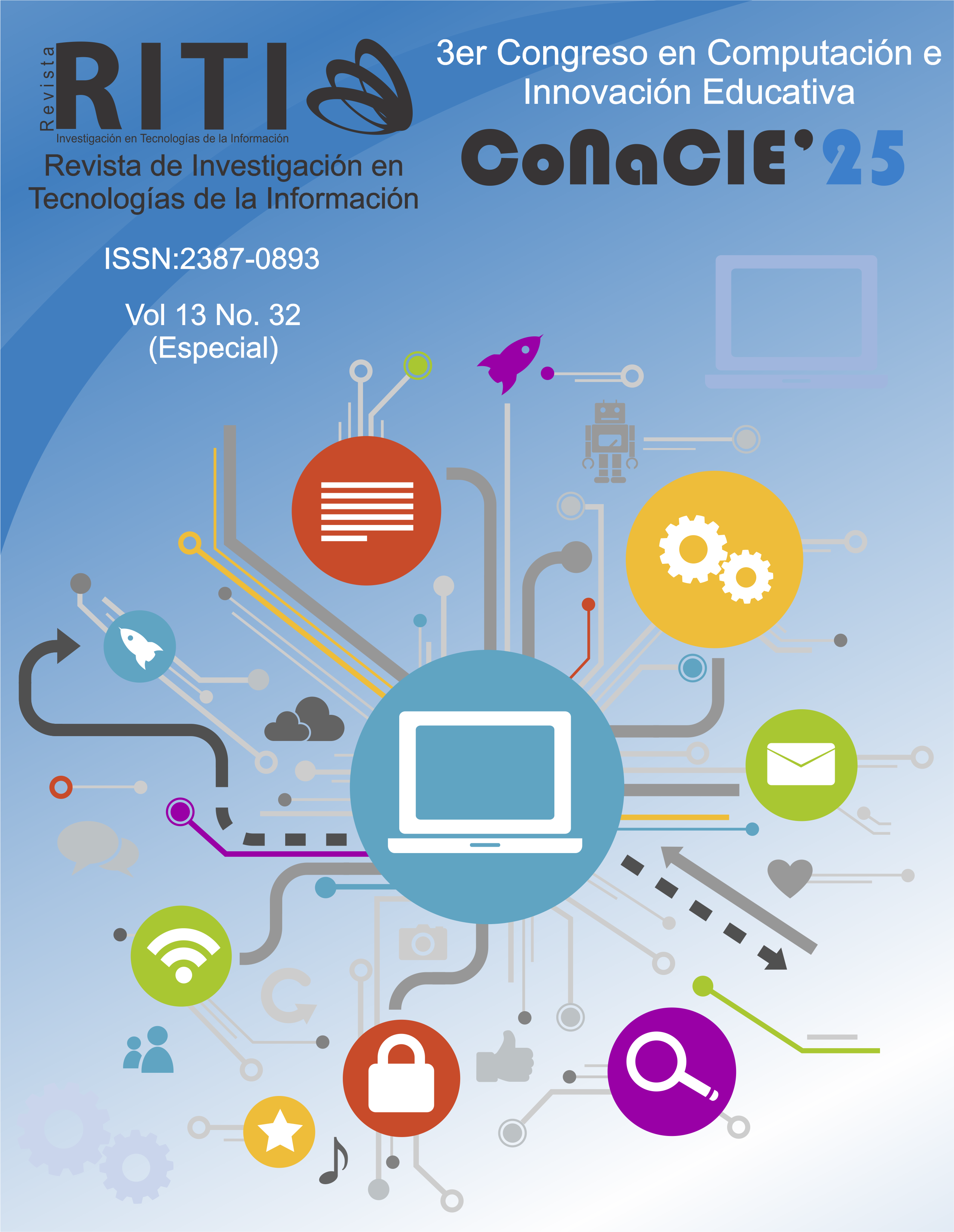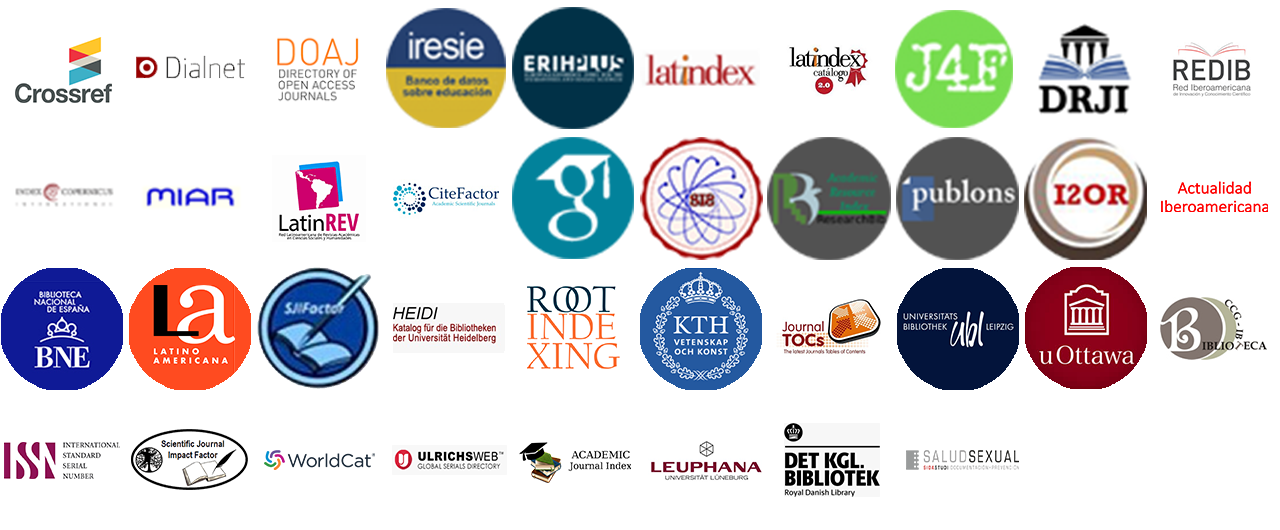Red neuronal convolucional para estimar humedad gravimétrica del suelo con bandas multiespectrales UAV
DOI:
https://doi.org/10.36825/RITI.13.32.004Palabras clave:
Redes Neuronales Convolucionales, UAV Multiespectral, Humedad Gravimétrica, Agricultura de Precisión, Gestión HídricaResumen
La estimación precisa de la humedad gravimétrica del suelo es esencial para la gestión eficiente de recursos hídricos en agricultura de precisión, especialmente en regiones semiáridas. Este estudio propone una red neuronal convolucional (CNN) para estimar la humedad gravimétrica del suelo utilizando datos multiespectrales adquiridos mediante vehículos aéreos no tripulados (UAV). La investigación se llevó a cabo en una parcela de suelo franco-arcilloso en Guasave, Sinaloa, México, durante diferentes fases de secado post-riego. Se empleó un dron DJI Mavic 3 Multispectral equipado con cámaras en las bandas Green (560 nm), Red (650 nm), Red-Edge (730 nm) y NIR (860 nm), obteniendo imágenes con resolución espacial aproximada de 4 cm/píxel. Se realizaron mediciones gravimétricas in situ para validar el desempeño del modelo CNN desarrollado. La arquitectura CNN propuesta constó de tres capas Conv1D con 32 filtros, una capa MaxPooling, una capa de aplanamiento y una capa densa, diseñada específicamente para explotar relaciones no lineales complejas entre las bandas espectrales y la humedad del suelo. Los resultados mostraron un desempeño excepcional del modelo con un error cuadrático medio (MSE) de 0.0058, un coeficiente de determinación (R²) de 0.91 y un error absoluto medio (MAE) de 0.046 en el conjunto de prueba. La correlación entre las predicciones y las mediciones reales fue alta (r = 0.92, p < 0.001). Los análisis estadísticos confirmaron la homocedasticidad y normalidad de los residuos, indicando robustez del modelo. Se destacó además la superioridad del enfoque CNN respecto a índices empíricos tradicionales, mostrando gran sensibilidad a microvariaciones intraparcelarias.
Citas
Rosegrant, M. W., Ringler, C., Zhu, T. (2009). Water for Agriculture: Maintaining Food Security under Growing Scarcity. Annual Review of Environment and Resources, 34 (1), 205–222. https://doi.org/10.1146/annurev.environ.030308.090351
Qian, Y., Zhu, Y., Ye, M., Huang, J., Wu, J. (2021). Experiment and numerical simulation for designing layout parameters of subsurface drainage pipes in arid agricultural areas. Agricultural Water Management, 243. https://doi.org/10.1016/j.agwat.2020.106455
Wisser, D., Frolking, S., Douglas, E. M., Fekete, B. M., Vörösmarty, C. J., Schumann, A. H. (2008). Global irrigation water demand: Variability and uncertainties arising from agricultural and climate data sets. Geophysical Research Letters, 35 (24), 1-5. https://doi.org/10.1029/2008GL035296
Dorigo, W., Himmelbauer, I., Aberer, D., Schremmer, L., Petrakovic, I., Zappa, L., Preimesberger, W., Xaver, A., Annor, F., Ardö, J., Baldocchi, D., Bitelli, M., Blöschl, G., Bogena, H., Brocca, L., Calvet, J.-C., Camarero, J. J., Capello, G., Choi, M., … Sabia, R. (2021). The International Soil Moisture Network: serving Earth system science for over a decade. Hydrology and Earth System Sciences, 25 (11), 5749–5804. https://doi.org/10.5194/hess-25-5749-2021
Katz, B. S., Stotler, R. L., Hirmas, D., Ludvigson, G., Smith, J. J., Whittemore, D. O. (2016). Geochemical Recharge Estimation and the Effects of a Declining Water Table. Vadose Zone Journal, 15 (10), 1–13. https://doi.org/10.2136/vzj2016.04.0031
Beck, H. E., Pan, M., Miralles, D. G., Reichle, R. H., Dorigo, W. A., Hahn, S., Sheffield, J., Karthikeyan, L., Balsamo, G., Parinussa, R. M., Van Dijk, A. I. J. M., Du, J., Kimball, J. S., Vergopolan, N., Wood, E. F. (2021). Evaluation of 18 satellite- and model-based soil moisture products using in situ measurements from 826 sensors. Hydrology and Earth System Sciences, 25 (1), 17–40. https://doi.org/10.5194/hess-25-17-2021
Harpold, A. A., Kaplan, M. L., Klos, P. Z., Link, T., McNamara, J. P., Rajagopal, S., Schumer, R., Steele, C. M. (2017). Rain or snow: hydrologic processes, observations, prediction, and research needs. Hydrology and Earth System Sciences, 21 (1), 1–22. https://doi.org/10.5194/hess-21-1-2017
Kerr, Y. H., Al-Yaari, A., Rodriguez-Fernandez, N., Parrens, M., Molero, B., Leroux, D., Bircher, S., Mahmoodi, A., Mialon, A., Richaume, P., Delwart, S., Al Bitar, A., Pellarin, T., Bindlish, R., Jackson, T. J., Rüdiger, C., Waldteufel, P., Mecklenburg, S., Wigneron, J.-P. (2016). Overview of SMOS performance in terms of global soil moisture monitoring after six years in operation. Remote Sensing of Environment, 180, 40–63. https://doi.org/10.1016/j.rse.2016.02.042
Rand, C. F., Khan, A. L. (2024). Applicability of Relatively Low-Cost Multispectral Uncrewed Aerial Systems for Surface Characterization of the Cryosphere. Remote Sensing, 16 (19), 1-17. https://doi.org/10.3390/rs16193662
Shi, P., Li, P., Li, Z., Sun, J., Wang, D., Min, Z. (2022). Effects of grass vegetation coverage and position on runoff and sediment yields on the slope of Loess Plateau, China. Agricultural Water Management, 259. https://doi.org/10.1016/j.agwat.2021.107231
Shokati, H., Mashal, M., Noroozi, A., Abkar, A. A., Mirzaei, S., Mohammadi-Doqozloo, Z., Taghizadeh-Mehrjardi, R., Khosravani, P., Nabiollahi, K., Scholten, T. (2024). Random Forest-Based Soil Moisture Estimation Using Sentinel-2, Landsat-8/9, and UAV-Based Hyperspectral Data. Remote Sensing, 16 (11), 1-17. https://doi.org/10.3390/rs16111962
Hegazi, E. H., Samak, A. A., Yang, L., Huang, R., Huang, J. (2023). Prediction of Soil Moisture Content from Sentinel-2 Images Using Convolutional Neural Network (CNN). Agronomy, 13 (3), 1-18. https://doi.org/10.3390/agronomy13030656
Brutsaert, W., Chen, D. (1995). Desorption and the two Stages of Drying of Natural Tallgrass Prairie. Water Resources Research, 31 (5), 1305–1313. https://doi.org/10.1029/95WR00323
Idso, S. B., Reginato, R. J., Jackson, R. D., Kimball, B. A., Nakayama, F. S. (1974). The Three Stages of Drying of a Field Soil. Soil Science Society of America Journal, 38 (5), 831–837. https://doi.org/10.2136/sssaj1974.03615995003800050037x
Seneviratne, S. I., Corti, T., Davin, E. L., Hirschi, M., Jaeger, E. B., Lehner, I., Orlowsky, B., Teuling, A. J. (2010). Investigating soil moisture–climate interactions in a changing climate: A review. Earth-Science Reviews, 99 (3–4), 125–161. https://doi.org/10.1016/j.earscirev.2010.02.004
Riese, F. M., Keller, S. (2019). felixriese/hyperspectral-soilmoisture-dataset: Dataset with universal DOI (Versión v1.0.3) [Software]. Zenodo. https://doi.org/10.5281/ZENODO.1227836
LeCun, Y., Bottou, L., Orr, G. B., Müller, K.-R. (1998). Efficient BackProp. En G. B. Orr, K.-R. Müller (Eds.), Neural Networks: Tricks of the Trade (pp. 9–50). Springer Berlin Heidelberg. https://doi.org/10.1007/3-540-49430-8_2
Hochreiter, S., Schmidhuber, J. (1997). Long Short-Term Memory. Neural Computation, 9 (8), 1735–1780. https://doi.org/10.1162/neco.1997.9.8.1735
Chai, T., Draxler, R. R. (2014). Root mean square error (RMSE) or mean absolute error (MAE)? – Arguments against avoiding RMSE in the literature. Geoscientific Model Development, 7 (3), 1247–1250. https://doi.org/10.5194/gmd-7-1247-2014
Shokati, H., Mashal, M., Noroozi, A., Abkar, A. A., Mirzaei, S., Mohammadi-Doqozloo, Z., Taghizadeh-Mehrjardi, R., Khosravani, P., Nabiollahi, K., Scholten, T. (2024). Random Forest-Based Soil Moisture Estimation Using Sentinel-2, Landsat-8/9, and UAV-Based Hyperspectral Data. Remote Sensing, 16 (11), 1962. https://doi.org/10.3390/rs16111962
Neely, W. R., Borsa, A. A., Burney, J. A., Levy, M. C., Silverii, F., Sneed, M. (2021). Characterization of Groundwater Recharge and Flow in California’s San Joaquin Valley From InSAR‐Observed Surface Deformation. Water Resources Research, 57 (4), 1-20. https://doi.org/10.1029/2020WR028451
Descargas
Publicado
Cómo citar
Número
Sección
Licencia
Derechos de autor 2025 Revista de Investigación en Tecnologías de la Información

Esta obra está bajo una licencia internacional Creative Commons Atribución-NoComercial 4.0.
Esta revista proporciona un acceso abierto a su contenido, basado en el principio de que ofrecer al público un acceso libre a las investigaciones ayuda a un mayor intercambio global del conocimiento.
El texto publicado en la Revista de Investigación en Tecnologías de la Información (RITI) se distribuye bajo la licencia Creative Commons (CC BY-NC
 ), que permite a terceros utilizar lo publicado citando a los autores del trabajo y a RITI, pero sin hacer uso del material con propósitos comerciales.
), que permite a terceros utilizar lo publicado citando a los autores del trabajo y a RITI, pero sin hacer uso del material con propósitos comerciales.



